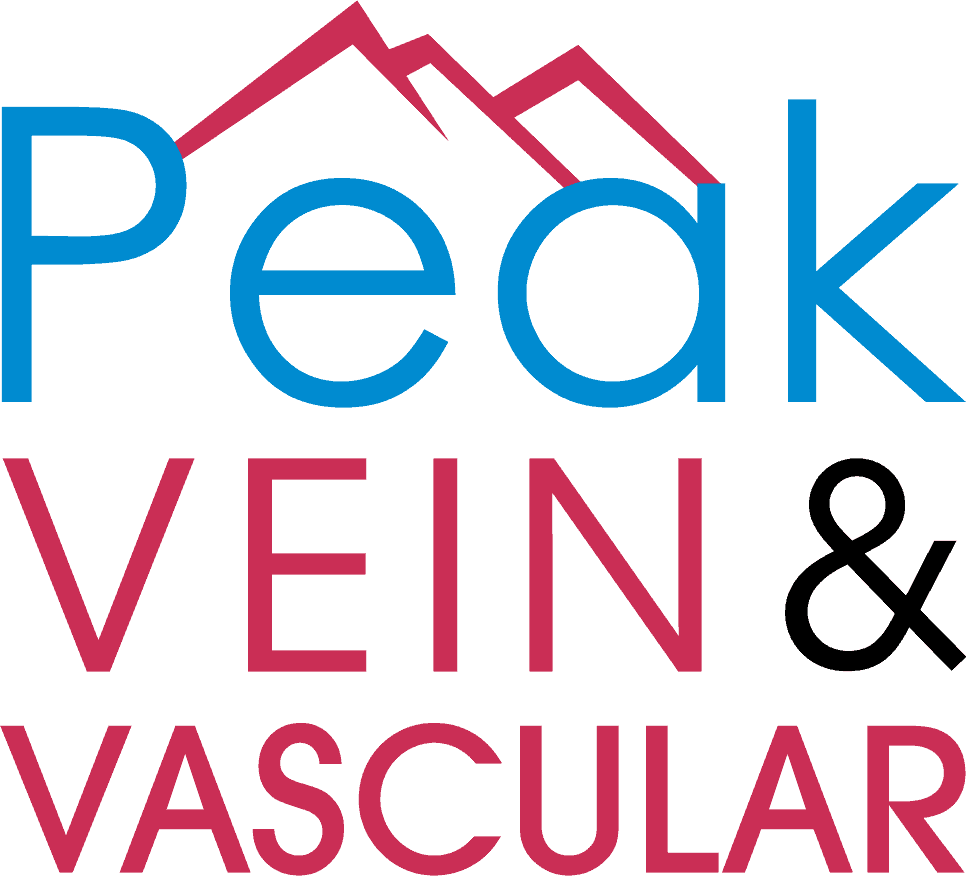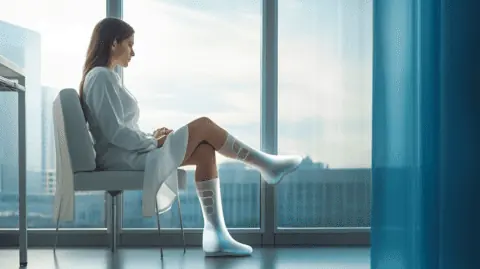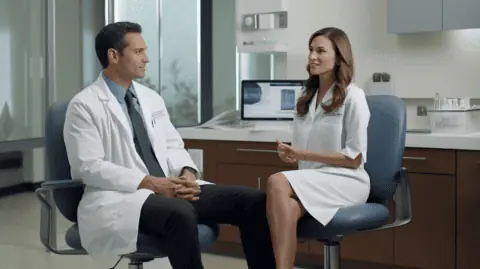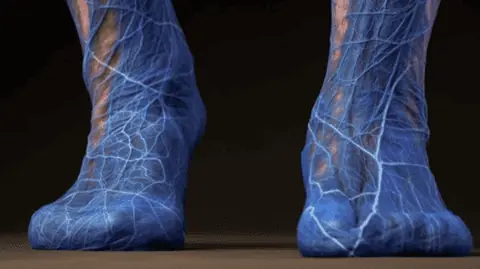Varicose veins can often become more than a cosmetic concern, leading to discomfort and further complications if left untreated. At Peak Vein & Vascular, we provide an array of treatments, including the simple yet effective use of compression stockings. In our quest to offer optimal vein care, we delve deep into how these unique hosiery pieces aid in managing varicose veins.
Understanding Varicose Veins
Varicose veins, a common ailment, are typically caused by weak or damaged vein walls and valves. The veins in our legs have one-way valves that prevent blood from flowing backwards. If these valves fail, blood begins to collect in the veins rather than continuing towards the heart, leading to enlarged and varicose veins. You can get a detailed insight about this condition from our comprehensive page on varicose veins.
Not everyone experiences symptoms beyond the visual irregularities, but for some, varicose veins can cause aching pain, throbbing, and discomfort. In some cases, they can lead to more serious health problems such as deep vein thrombosis. Thus, effective management and treatment are crucial.
The Compression Stockings Solution
Compression stockings are specially designed to apply pressure to your lower legs, helping to maintain blood flow and reduce discomfort and swelling. They deliver a controlled amount of pressure which is strongest at the ankle and gradually decreases towards the top of the hose.
They’re an integral part of our treatment plans, serving as a first-line remedy or an adjunct to other procedures like sclerotherapy or VNUS closure.
There is more to these stockings than meets the eye. They’re not just a tool for symptom management but also play a preventive role. By improving blood flow and reducing the pooling of blood within the veins, compression stockings can prevent the progression of venous disorders and their associated symptoms. They can also help reduce the risk of venous ulcers, a common complication of untreated varicose veins.
How They Work
It’s all about gravity. Standing and walking upright increases the pressure in the veins of your lower body. Compression stockings exert pressure on the limbs, reducing the diameter of major veins, which increases blood flow velocity and improves the effectiveness of the vein valves.
From our FAQ section, patients often ask how long they should wear these stockings. While it largely depends on the individual’s condition, wearing them throughout the day is generally most beneficial, as symptoms like leg heaviness or swelling tend to worsen as the day progresses.
Affordability and Insurance Coverage
An added benefit of this approach to managing varicose veins is its affordability. Unlike some vein procedures, compression stockings won’t cause a significant dent in your wallet. Many patients also find comfort in knowing that these stockings are often covered by insurance, depending on the patient’s insurance plan and the severity of the venous disease.
To understand the complete range of our insurance coverage, patients can check our insurance options page. At Peak Vein & Vascular, we’re committed to providing accessible care to all patients.
Stay tuned as we explore further into the fitting and use of compression stockings and how our individualized approach at Peak Vein & Vascular tailors the right fit for you in the next sections of this article. For additional information on various vein conditions, treatments, and health tips, our blog serves as a helpful resource.
Optimal Fitting of Compression Stockings
Effective use of compression stockings hinges on their correct fitting. It’s paramount that the stockings are neither too loose nor too tight. A wrong fit could exacerbate the symptoms and potentially lead to new issues. For example, if the stockings are too tight, they could cut off circulation instead of promoting it.
We provide professional fitting guidance at Peak Vein & Vascular. As part of our approach, we understand that every individual has unique requirements, and we strive to ensure that the fit is perfect for each patient.
Measurements for compression stockings are taken early in the morning when your legs are the least swollen. Sizes depend on the ankle and calf circumference, and the length of your leg. Stockings come in different lengths, including knee-high and thigh-high styles, and the selection is typically based on the area affected by varicose veins.
After the fitting, we give specific instructions on how to wear and care for your stockings. It might feel awkward or a bit difficult to put on compression stockings at first, especially if this is your first time wearing them. But don’t worry, like many of our patients who have shared their experiences in our patient testimonials, you will get the hang of it in no time.
Different Types of Compression Stockings
Compression stockings are not a one-size-fits-all solution. In addition to the perfect fit, the right level of compression is also important. Compression stockings come in several types, offering varying degrees of pressure measured in millimeters of mercury (mmHg).
For most people with varicose veins, medium-grade compression (20-30 mmHg) stockings are sufficient. However, certain individuals might require a different compression level. It’s also worth noting that some stockings are designed for active wear and sports, helping athletes manage symptoms of venous insufficiency and speed up recovery.
In our services we offer, we provide a range of compression stockings with different styles and colors, catering to various lifestyle and fashion preferences. We make sure that wearing compression stockings doesn’t only serve therapeutic purposes but can also be an enjoyable experience.
Compression Stockings as a Complementary Treatment
While compression stockings play an important role in managing varicose veins, it’s crucial to understand that they don’t fix the underlying problem. These stockings help manage symptoms and prevent the condition from worsening, but they typically cannot improve existing varicosities.
That’s why at Peak Vein & Vascular, we offer multiple treatment options for varicose veins. Compression stockings can serve as an adjunct to procedures like phlebectomy and VNUS closure. These procedures remove or close off affected veins, addressing the root cause of the issue.
As we continue this discussion, the last section of the article will discuss the potential side effects and contraindications of using compression stockings, our approach to ensuring patient privacy, and how to reach out to us for consultation. Visit our contact us page if you wish to schedule a consultation sooner.
Contraindications and Potential Side Effects
While compression stockings are generally considered safe, they’re not suitable for everyone. Certain medical conditions may make their use potentially risky. For instance, people with peripheral artery disease, dermatitis, or any skin infections may not be advised to use compression stockings. Our team at Peak Vein & Vascular can help determine whether compression stockings are safe for you as part of our comprehensive patient resources.
It’s also important to be aware of potential side effects, including skin irritation and discomfort. In rare cases, improperly fitted stockings can cause circulation problems. That’s why professional fitting and regular follow-ups are key to ensuring both the safety and efficacy of this treatment.
Your Privacy Matters to Us
We understand that dealing with a medical condition like varicose veins can be a deeply personal matter. That’s why we take patient privacy very seriously. Our privacy policy outlines how we protect your personal information, reinforcing our commitment to maintaining your confidentiality and trust.
Reach Out to Us Today
Do you have more questions about compression stockings or varicose vein treatments? Maybe you’re interested in knowing how our procedures are covered by insurance or seeking more insights from our FAQ? Visit our blog for more informative articles on venous health.
At Peak Vein & Vascular, we pride ourselves on our patient-centered approach. We’re not just a healthcare provider; we’re a partner in your journey towards better venous health. We encourage you to reach out to us through our contact us page or pay us a visit at our Dallas, Texas location.
Remember, varicose veins don’t have to dictate your life. With the right treatments, advice, and preventative measures such as compression stockings, you can manage this condition and live a fulfilling, active life. Reach out to us today and let’s journey together towards better health.
Key Takeaways
- Compression stockings play a significant role in managing varicose veins by aiding venous blood flow, reducing pain and swelling, and preventing complications.
- At Peak Vein & Vascular, we use a patient-centered approach to offer various treatments for venous conditions, including phlebectomy, VNUS Closure, and sclerotherapy.
- Our experts also deal with other venous conditions like spider veins, deep vein thrombosis, and venous ulcers.
- Wearing compression stockings can enhance the effectiveness of the treatments we provide and improve overall vein health.
- While compression stockings are generally safe, they’re not suitable for everyone. Certain conditions might make their use potentially risky. We provide resources to help determine the safety and efficacy of this treatment for each patient.
- We take patient privacy very seriously, protecting all personal information as outlined in our privacy policy.
- For any questions about compression stockings or varicose vein treatments, or for more insights on venous health, we encourage reaching out to us or visiting our blog.
- With the right treatments, advice, and preventative measures, varicose veins can be effectively managed for an active, fulfilling life.






